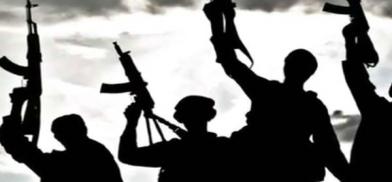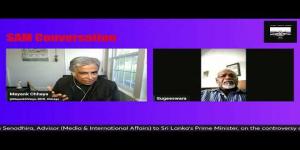Dangerous nexus between right-wing forces and terrorism in Bangladesh
The right-wing and Islamist political forces that have always maintained connections with violent extremist forces are exerting their influence in Bangladeshi society. This is an ominous sign in this part of the world.

Although terrorism which is broadly understood as violent extremism or militancy has long historical roots, in Bangladesh it surfaced in the 1970s through leftist militants. Later, it shifted to Islamist extremism in the 1980s and flourished throughout the 1990s, and reached its peak in the early 2000s. The menace of terrorism particularly in the form of Islamic militancy has widely been felt in Bangladesh's society and polity since 1999.
Since then, several militant groups have gained ground and started to challenge the government over the issues of the political process and social systems in the country. The central goal of the operations of the militant groups is to establish an Islamic regime in the country. The Fifth Amendment of the Bangladesh Constitution under the Zia regime in the late 1970s and the Eighth Amendment of the Constitution under the Ershad regime in the early 1980s, which gave centrality to Islam at the State level, encouraged religious and right-wing forces to grab state power.
On the other hand, the secular Constitution of Bangabandhu Sheikh Mujibur Rahman in 1972 separated religion from the State and prohibited religion-based political parties. This was reversed by the military dictators in the name of multiparty democracy. Since then Bangladesh has witnessed the emergence of right-wing Islamist forces.
Understandably, the contemporary variant of extremism experienced by Bangladesh is the religious one and is the product of the Afghan War (1979-1992). The connection with the Afghan War was established in 1984 when estimated 3,000 volunteers traveled to Afghanistan. When the Mujahideen emerged victorious, the Bangladeshi participants of the war expressed their delight at a press conference in Dhaka where the speakers identified themselves as members of HuJI-Bangladesh (HuJI-B).
Rise of extremist groups
In the second half of the 1990s, a number of religious extremist groups emerged in Bangladesh with different objectives. The first terrorist incident in Bangladesh inspired by this religious extremism experienced and perpetrated by HuJI-B was the bombing at a venue of a cultural programme organized by Udichi in 1999 that killed 10 people and injured around 150.
During the same period, other extremist groups viz., the Jagrata Muslim Janata, Bangladesh (JMJB) and the Jamaat-al Mujahedin Bangladesh (JMB) also emerged and started functioning in Bangladesh. Their purported motivation was to wage "Islamic movements" in Bangladesh and ultimately establish an ‘Islamic state’ based on Shariah law.
From 6 March 1999 to 29 November 2005, at least 23 bombing incidents were launched by different militant-terrorist groups, which left some 142 people dead and thousands injured. Militancy reached its peak with the attack on Sheikh Hasina, then out of power, at a political rally on 21 August 2004, followed by the biggest terrorist incident on August 17, 2005, when activists of the JMJB detonated 459 bombs in 63 out of the 64 districts of the country. To mention some other violent attacks: the bomb explosion at Ramna on the eve of Bengali New Year in April 2001; the 27 January 2005 attack in Habiganj killing the then Finance Minister; courtroom and court premises bomb blasts in October and November of 2005 killing two district judges in Jhalokathi district. Most of these attacks were carried out by the JMB.
The BNP-led government (2001-2006) initially failed to take action against the attackers due to limited law enforcement capacity but also sympathy for these groups within the Jamaat-e-Islami (JeI), Bangladesh’s largest Islamist party and a member of the BNP’s governing alliance. However, Bangladesh successfully tackled that wave of terrorism with top JMB leaders facing justice, thanks to actions by its Rapid Action Battalion (RAB).
After a hiatus of six to seven years, there was a resurgence of terrorism starting with the killing of Blogger Rajib Haider in February 2013, an activist of the Gono Jagoron Mancho (mass upsurge stage) that emerged to protest the International Crime Tribunal verdict of Jamaat-e-Islami Assistant Secretary General Abdul Kader Molla. From 2013, about 70 terror attacks have been carried out, and about 52 in the next 18 months on diversified targets including bloggers, preachers, academic, social, and religious minorities, and also foreigners. In July 2016, came the horrendous Holey Artisan Bakery attacks which killed 22 people, including 17 foreigners.
Root cause of extremism
It seems the incidents of extremism had accelerated in the form of political violence with the linkages of religious fundamentalist forces and right-wing political parties. Major political parties that came to power in the mid-1970s formed alliances with Islamic groups. With direct and indirect linkages of Islamic political parties, radical Islamism has taken a durable shape in Bangladesh.
Understanding the root causes of extremism is critically important to understand its uniqueness in Bangladesh. There are different sources of extremism in Bangladesh leading to the acts of violence and terrorism: (i) proliferation of Islam-based institutions and organizations in the country; (ii) rise of power-seeking Islamist extremism, (iii) rigid religious beliefs, grievances, and subcultures of conspiracy; (iv) misinterpretation of religious ideologies; (v) political instability that providing opportunities for extremists; (vi) radicalization; and (viii) regional and global connections.
Many analysts claim that a link exists between Islam-based political groups and extremism in Bangladesh. The proliferation of these institutions and organizations is an overt manifestation of extremism. The rejuvenation of the Islamic political parties in Bangladesh can also be explained in terms of the enhanced role of terrorist groups in Bangladesh politics. Many radical clerics also rail against the secular segments of society.
Efforts to curb terrorism
The leadership of Sheikh Hasina, who came to power in 2009 with a strong determination to curb extremist forces from Bangladesh, and the re-emergence of non-communal and secular forces have reversed the political environment created by the erstwhile political regimes. The Hasina government introduced a zero-tolerance policy and amended the Anti-Terrorism Act to combat politically and religiously motivated extremism in Bangladesh. The government has taken a two-pronged strategy to deal with radical, fundamentalist, and communal forces. The counter-terrorism and anti-terrorism capacity of the state have been bolstered and cultural, social and community engagement have been expanded. And, the role of civil society actors has been emphasized at the government and non-governmental levels.
The zero-tolerance policy has had positive outcomes. However, the threat of terrorism looms large in society as terrorism only changes form and method. The emergence of a nascent organization, Jamatul Sharqiya, and Al-Qaeda Indian Subcontinent (AQIS) are now posing threat to the country and the region.
The right-wing and Islamist political forces that have always maintained connections with violent extremist forces are exerting their influence in Bangladeshi society. This is an ominous sign in this part of the world. Bangladesh should not become a state run by right-wing forces having linkages with militant and extremist forces. This reminds the era of the 1990s and 2000s when they created a reign of terror. This was the time when many analysts predicted Bangladesh will become like "Taliban-ruled Afghanistan". Many terrorist and radical groups even chanted slogans that Bangla (Bangladesh) would become Afghanistan.
The dangerous nexus between right-wing forces and terrorism needs to be seen from a proper perspective for peace, stability, and prosperity in Bangladesh and the greater sub-region of South Asia.
(The author is a retired Bangladesh government official. Views are personal. He can be contacted at shafiqul.elahi1960@gmail.com)














Post a Comment